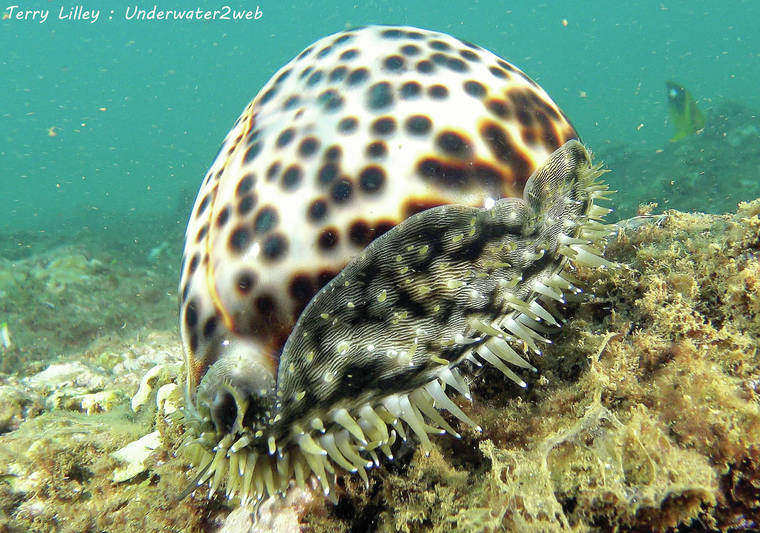The Hawaiian tiger cowry is one of the largest cowries in the world, and one of Hawai‘i’s most famous shells. Most people have seen them for sale in shell shops, jewelry stores and variety stores, as this six-inch marine snail is extremely beautiful and has been over-collected for so many years in Hawai‘i that it is now rare to find one alive out on the reef.
The Hawaiian tiger cowry is one of the largest cowries in the world, and one of Hawai‘i’s most famous shells. Most people have seen them for sale in shell shops, jewelry stores and variety stores, as this six-inch marine snail is extremely beautiful and has been over-collected for so many years in Hawai‘i that it is now rare to find one alive out on the reef.
They live in depths of about 10 feet to 60 feet deep and can range from almost pure black to pure white, but always have the shiny, polished shell with black polka dots. When diving you can sometimes see them on the reef over 30 feet away because their color contrasts with the dark lava reef and they have such large, thick shells so they don’t normally try to hide like the smaller cowrie shells do.
Most of the Hawaiian cowry shells are called “leho” and were used in Hawaiian culture as fishing lures to catch he‘e the octopus. One of the only sea creatures that can eat a cowry shell is the octopus that uses its hard beak to drill a hole in the top of the cowry shell and eat the soft snail inside. People often find these cowry shells on the beach that look like someone took a saw and cut off the entire top of the shell.
Live cowry shells are always super beautiful and shiny, as if they get a daily polish. And they do. The snail that lives inside the shell has a mantle or foot that expands and covers the entire outer shell. This soft, fleshy mantle has branching projections called papillae that keep the shell clean and polished. Most people when they see the live cowry with its mantle out they do not recognize it as a cowry shell until the snail gets frightened and retracts the mantle into the shell for protection.
Live leho are super important to leave out on the reef and not collect to display or sell. These marine snails feed on certain algae and sponge species that grow on the live coral reef. If all of the marine snails are removed then the algae can grow out of control and kill the corals, so the Hawaiian tiger cowry has an important part to play on the reef by keeping the coral and algae in balance.
You can see leho in action in the movie “The World’s Guide To Hawaiian Reef Creatures” at underwater2web.com, and follow the daily marine-life post on my Facebook page and Instagram listed under my name.
Aloha from under the surf.
•••
Terry Lilley, a marine biologist, lives in Hanalei. His websites include underwater-2web.com and www.gofundme.com/5urrm4zw.

Subscribe today for unlimited access.
Already a subscriber?
Login
Not ready to subscribe?
Register for limited access.
If you have a print subscription but require digital access,
activate your account.





